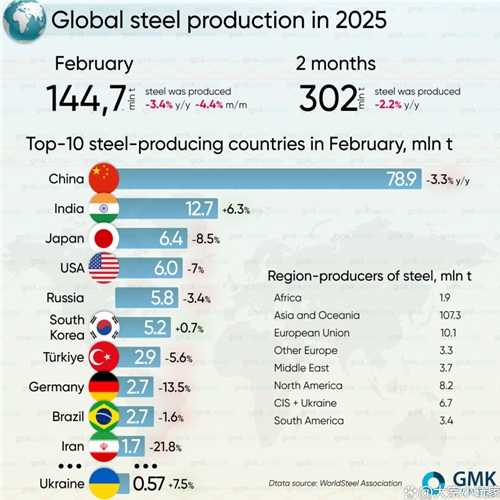
According to the latest statistics from the World Steel Association, global steel production in February 2025 was 144.7 million tons, a decrease of 3.4% compared to the same period in 2024 and a decrease of 4.4% compared to the previous month. This data reflects changes in the global steel market, particularly evident in the performance of 69 major steel producing countries.
China: 78.9 million tons (YoY -3.3%)
India: 12.7 million tons (+6.3%)
Japan: 6.4 million tons (-8.5%)
United States: 6 million tons (-7%)
Russia: 5.8 million tons (-3.4%)
South Korea: 5.2 million tons (+0.7%)
Türkiye: 2.9 million tons (-5.6%)
Germany: 2.7 million tons (-13.5%)
Brazil: 2.7 million tons (-1.6%)
Iran: 1.7 million tons (-21.8%)

Production dynamics of the Commonwealth of Independent States and Ukraine
The steel production in the CIS countries and Ukraine is also facing difficulties. According to statistics, crude steel production in August decreased by 1.9% year-on-year and 4.3% month on month, to 6.7 million tons. Ukraine's crude steel production was affected by the war, with a year-on-year decrease of 7.5% and a month on month decrease of 6.4%, with a production of only 571800 tons.
In the first two months of 2025, global steel production decreased by 2.2% year-on-year to 302 million tons, with the CIS+Ukraine region experiencing a smaller year-on-year decline of only 0.7% to 13.6 million tons. This shows that amidst economic turmoil, Ukraine's steel production is gradually recovering, with a production of 1.18 million tons in the first two months, a year-on-year increase of 9.9%.
Summarize
Overall, the production data of the global steel industry in February 2025 presents a challenging market landscape. The production performance of different countries varies, and the future trend of the steel market will be influenced by various factors, including international trade policies, global economic situation, etc. Despite current data showing weakness in the steel industry, some countries still demonstrate growth potential.
At this point, for industry participants, timely understanding of the dynamics and trends of the global steel market will be an important basis for formulating future development strategies. I hope that countries can find opportunities in adversity and promote the sustainable development of the steel industry.
